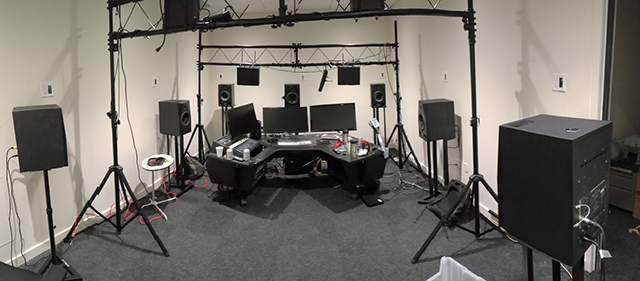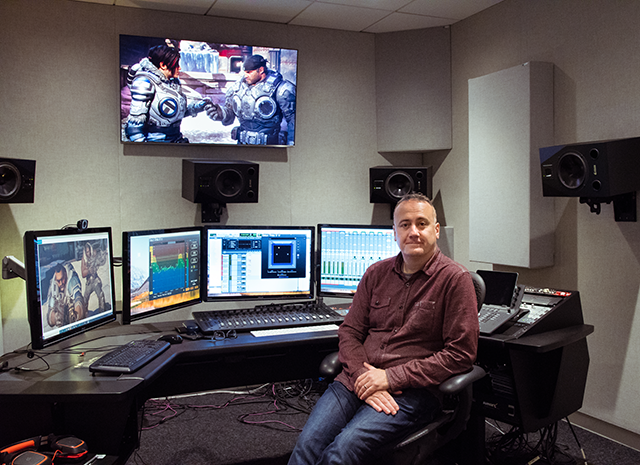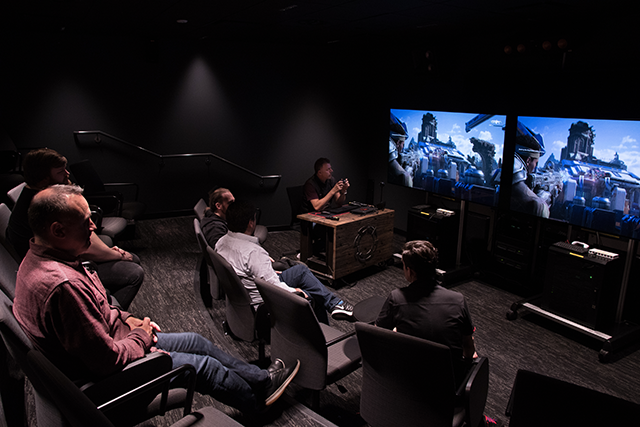Sounding Off with Gears 5
The sound-stage in Gears 5 is amazing, but that's really no suprise, as the audio team at the Coalition always goes above and beyond with their designs. We recently interviewed Josh Osiris, Sr. Sound Designer about the sound design, use of spatial audio and studio set-up for this latest Coalition release.
Q - Can you tell us a little bit about your sound design for Gears 5 and how you wanted to change things up from Gears of War 4?
A - After Gears 4 shipped, we took a step back and looked at how we could improve the soundscape and audio presentation for the next game. One of the guiding principles was to bring clarity and focus that supports gameplay in a way that feels natural. Foley and Weapons are a huge part of game feedback, so we focused here early on. For example, Edward Bauman remastered our entire foley set to make it clearer and more dynamic. I remastered the Lancer to bring back some of the punch that was lost over a few games of iteration, and remove much of the noise, while Ed added some medium and far distance content to help the player know how far away the shots are.
In Gears 4, we used a sweetener to tell the player when they’ve hit an enemy, but there was no differentiation between a regular hit and a weakspot. The weakspots now have their own treatment and vary depending on the type of character being shot. We also used to mix headshots the same way regardless if the player got the headshot, or someone else. Now we put more emphasis on headshots by the player, since it’s such a satisfying moment, and headshots by an enemy to draw attention to the threat.
On the environment side of things, we no longer use volumes that flip On/Off 2D ambient beds, but instead heavily lean into point emitter sounds. This uses more memory and voices, but it spatializes much better, and gives us a more convincing and natural sounding environment that takes advantage of the Atmos height channels.
John Morgan and Clarence Chu put a lot of effort into upgrading and tuning our real time acoustics system which combines Microsoft Research’s “Triton” and AudioKinetic’s “Wwise Reflect”. This has to be heard to understand how amazing it is. You can feel the size of a space and the kind of material it is made of. I’ve never heard anything like it in a game before!
We also overhauled the mixing system to help focus the player’s attention on what is most important from moment to moment. Jimmy Smith and I added a threat based priority system, coupled with Wwise HDR, that dynamically focuses the mix on higher threat characters over lower threat characters. We also implemented player, squad and enemy content separately to further focus priority, and improve performance.
I built a multi-band sidechain compressor in Wwise to help prioritize each of our sub-mixes (i.e. Speech, Weapons, Foley, Music, Environment) by dynamically ducking lower priority content in a way that feels more natural than a traditional single band ducking system. Each of these sub-mixes respond to the rest of the game, by dynamically lowering and raising itself to fit the overall loudness of the game at any given moment.
The dynamic mix, occlusion from Triton, and height channels together deliver such precise moment to moment feedback, that playing with Atmos, whether using Atmos for Headphones, or an Atmos for Home Theatre system, gives the player a definitive advantage over someone that is not playing with Atmos.
Q- You supported spatial audio in Gears of War 4, did you do anything differently in the design or studio process for Gears 5?
A- Work on Dolby Atmos for Gears 4 was started after the game launched, and at the time, we did not have an audio room large enough for all the speakers, so we jury-rigged a speaker system in a meeting room that was just big enough for us to hear that sounds were coming out of the correct speakers! We were in the middle of renovations, which included a Dolby Atmos mixing room and theatre. Once the walls went up in the mixing room, we moved the gear there, and I started on the Dolby Atmos remix and tuning.

Panorama of the Dolby Atmos “Mixing” room used for Gears 4 + a bunch of my garbage.
Since we were the first console game to support Dolby Atmos, much of the time was spent working out bugs, experimenting with what we could and could not do, and figuring out our best approach for that game, with the intent to use this knowledge at the start of Gears 5. We were not able to go back and remix the cinematics for Dolby Atmos, but all gameplay in Gears of War 4 is presented in Dolby Atmos.
One thing we learned during Gears of War 4, that we also did in Gears 5, was to keep foley and speech in the 7.1 bed. Due to being a 3rd person game, the camera is above the player and slightly tilted forward at its default position. This made footsteps and speech play a bit in the front height channels most of the time, which felt unnatural and confusing.
Q- Can you share a bit about your studio set-up and the workflow you have for mixing spatial audio?
A- After we completed the Gears of War 4 Dolby Atmos upgrade, we continued renovations in the Dolby Atmos mixing room. Frank Faugno, with assistance from Logan Wall, did most of the cinematic editing, designing, mixing and mastering, except for a few cinematics that were done by our friends at SourceSound.
Cinematics were mixed in Pro Tools and output as 7.1.4 stems, rather than 7.1 + 3D Objects, because our version of Wwise is unable to read the encoded object data.

Frank Faugno in the finished Dolby Atmos Mixing room
Mixing and Audio reviews for gameplay and cinematics were often done in our Dolby Atmos theatre, where we were able to hear the game in its full glory! We spent plenty of time mixing and reviewing in 7.1, 5.1, stereo and Dolby Atmos for headphones as well, to ensure the game sounded great no matter what kind of system a player is using.
Unfortunately, Wwise does not yet have much in the way of dynamic Dolby Atmos mixing tools, so for the most part sounds pan to where they should be, and that’s it. Except for foley and speech, that we restricted to 7.1.

The Dolby Atmos review theatre
Q- Is there a moment or scene in the game where you feel that Dolby Atmos really shines?
A- The opening gameplay has the player descend a rope from a helicopter into a cenote. There are lots of point emitters that give a wonderful sense of foliage and wildlife all around the player. It’s a fantastic introduction to Dolby Atmos.
There’s also a cinematic early in the game where JD gets hit by the Hammer of Dawn, it sounds amazing! And of course, any time the Condor or Raven fly overhead is pretty cool.
------
Big thanks to Josh for making the time to talk with us. Gears 5 is the Coalition's second Dolby Atmos title, and we think it sounds fantastic. Pick up Gears 5 today and decide for yourself!
Josh Osiris is an MPSE award winning sound designer that has been in the games industry since 2005. After completing a degree in Sound Design at the Vancouver Film School, he started his career designing and building numerous adaptive audio systems that brought life and excitement to the cars of Need for Speed. He has since served as sound designer, audio lead and technical artist on dozens of video games and multi-media projects of every scale at Microsoft Vancouver. He currently focuses his talents on Gears of War as Senior Sound Designer and Technical Audio Artist.